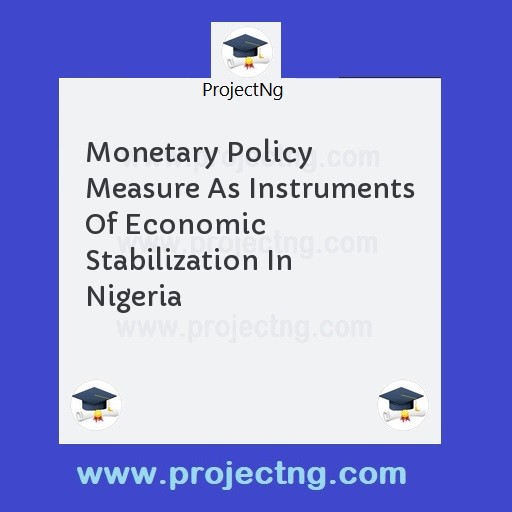Monetary Policy Measure As Instruments Of Economic Stabilization In Nigeria
Accounting Project Topics
Get the Complete Project Materials Now! »
MONETARY POLICY MEASURE AS INSTRUMENTS OF ECONOMIC STABILIZATION IN NIGERIA
ABSTRACT
MONETARY POLICY MEASURES AS INSTRUMENTS OF ECONOMIC STABILIZATION IN NIGERIA
In general, monetary policy refers to the combination of measures designed to regulates the value, supply and cost of money in an economy in cognizance with the level of economic activity. An express supply of money which will result in an excess demand for goods and services will cause rising prices and or a deterioration of the balance of payments position. On the other hand, inadequate supply of money could induce stagnation in the economy thereby referred growth and development. Consequently, the central bank and the central monetary authority, must attempt to keep the money supply growing at an appropriate rate to ensure sustainable economic growth and to maintain internal and external stability. The discretionary control of the money stock by the central monetary authority involves the expansion or construction of money influencing interest rates to make money cheaper or more expensive depending on the prevailing economic conditions and the channeling of money to priority sector. In a nutshell, the aims of monetary policy are basically to control inflation, maintain a healthy balance of payments position for the country in-order to safeguard the external value of the national currency and promote an adequate and sustainable level of economic growth and development.
This study therefore, delves into monetary policy measure with a view to elucidating their effectiveness as instruments of economic stabilization in Nigeria.
TABLE OF CONTENTS
Title page
Certification
Dedication
Acknowledgement
Abstract
List of tables
List of chart
CHAPTER ONE
1.0 Introduction
1.1 Background of the study
1.2 Statement of the problem
1.3 Statements of objectives
1.4 Research hypothesis
1.5 Significance of the study
1.6 Scope and limitation of the study
1.7 Propositions
1.8 Definition of terms
CHAPTER TWO
2.0 Literature review
2.1 Definition of monetary policy
2.2 Economic stabilization
2.3 Monetary policy objectives and economic stabilization
2.4 Analysis of key policy objectives/economic indications
2.5 Techniques and instruments of monetary policy
2.6 Debt management as integral part of monetary policy
2.7 Placement of government deposits
2.8 The transmission mechanism
CHAPTER THREE
3.0 Research methodology
3.1 Research design
1.2 Sources of data
1.3 Data collection method
1.4 Treatment and analysis of data
1.5 Statement of null and alternatives hypothesis
CHAPTER FOUR
4.0 Presentation, interpretation and analysis of data
4.1 Analysis based on objectives
4.2 Hypothesis testing
4.3 Discussion
CHAPTER FIVE
5.0 Summary of findings, recommendations and collusion
5.1 Summary of findings
5.2 Recommendations
5.3 Conclusion
Reference
Bibliography
CHAPTER ONE
1.0 INTRODUCTION
1.1 BACGROUND OF THE STUDY
Generally monetary control measure include those devices that influence the overall supply, cost and availability of money and credit. This is the responsibility of the monetary authority which comprises the central bank and the federal government in Nigeria, the central bank exercises primary responsibilities for initiating, articulating, implementing and appraising such policies. The banks proposal are subject to ratification by the federal government.
Monetary policy measures are monetary management techniques put in place by the government through the central bank to control money stock that is supply of money in order to influence broad macro-economic objectives which include price stability high level of employment, sustainable economic growth and a balance of payment equilibrium. These broad objectives are achieved through the use of appropriate instruments, depending on which objective the policy formulated want to achieve and on the level of development of the economy.
In the application of monetary policy measures as instruments of stabilization of the economy, here these instruments are determined by the nature of the problems to be solved and by the environment in which these problems exist. There are broadly two categories of hese instrument viz, quantitative or indirect controls and selective (qualitative or direct) controls. Indirect instruments are usually used in market based economic where the quantity of money stock can be affected through the relationship between money supply and reserve money as well as the ability of the monetary authority to influence the creation of reserves. The reserves and hence, money supply can be affected through the following ways:
i. Change in reserves deposit ratio
ii. Change in discount rate
iii. Interest rate change and
iv. Engaging in open market operation (OMO)
In an under-developed financial environment, the instruments of monetary and credit targets at desired levels. The major direct control
Be the First to Share On Social

Enjoying our content?
Don't miss out on new videos! Subscribe to our YouTube channel for more awesome content.
Subscribe Now!













